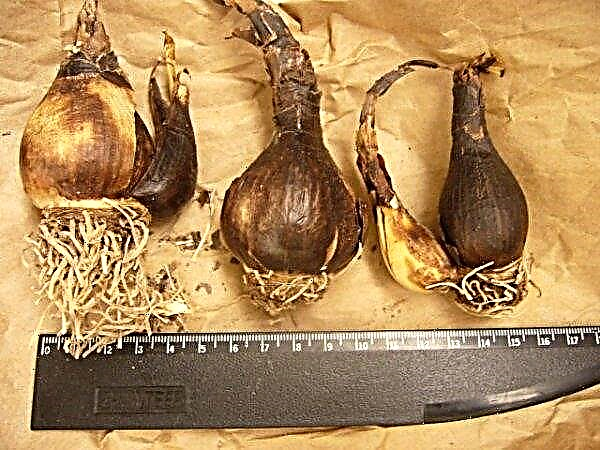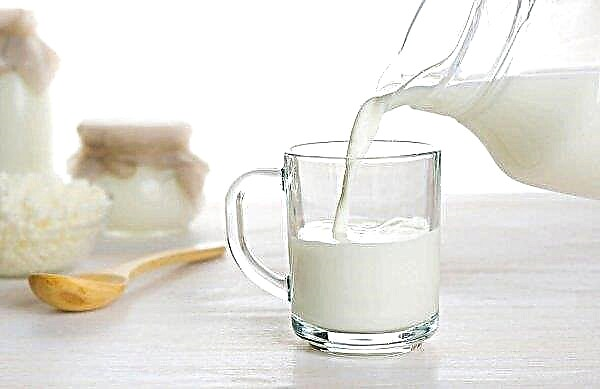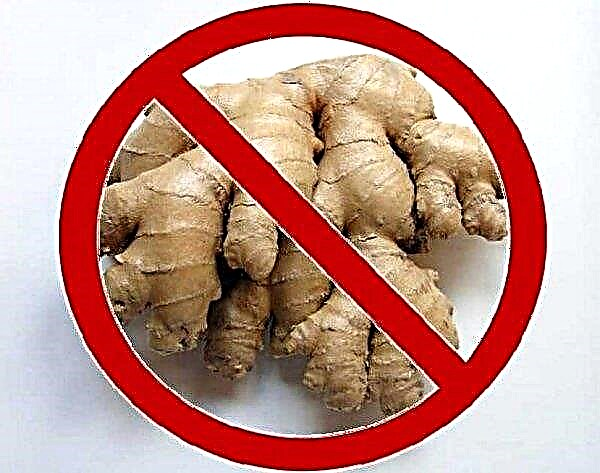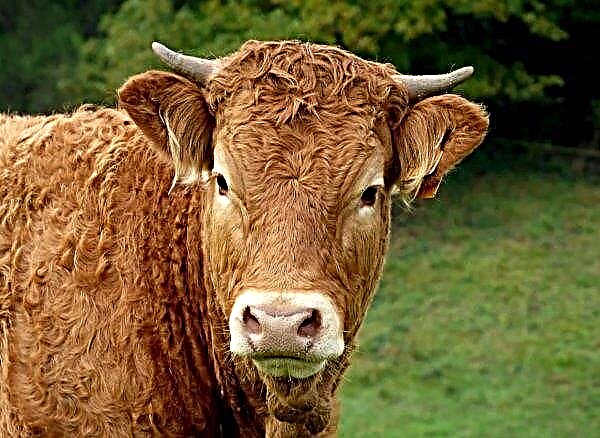Cow's milk is a product that has been consumed by humans for several millennia and is distinguished by its rich chemical composition: it contains more than 50 mineral elements. A quality drink has a sweetish flavor. However, there are times when a cow begins to produce a product with a specific smell, color and taste, brackish or bitter. Read about the causes of this phenomenon below.
How is the taste of milk formed?
During the lactation period, the cow gives not the same milk. Its qualities also change from lactation to lactation. In addition, the drink may differ in different parts of the udder. The following factors affect the taste, color, texture, calorie content and composition of milk:
The following factors affect the taste, color, texture, calorie content and composition of milk:
- season;
- conditions of detention;
- feeding ration;
- health status;
- age;
- frequency of milking.
Did you know? For one year of lactation, the composition, type and taste of milk can change up to three times.
In the process of milk formation, in the first place, 2 systems are involved: lymphatic and circulatory. In fact, milk is formed from blood, which in the mammary glands is saturated with sugar, fat and calcium. To develop 1 liter of milk, the mammary glands need to pass through themselves about 500 liters of blood.
It is from the blood that nutrients enter milk. They, in turn, come from the food. Therefore, an important condition for obtaining a high-quality white drink is nutrition. In the diet of the cow for stable and high-quality milk yield must be present:
- hay;
- green feed;
- compound feed;
- roots;
- cake;
- mineral supplements.
 The taste of milk given by a cow is primarily affected by the level of lactose, fatty acids, chlorides, and proteins in it.
The taste of milk given by a cow is primarily affected by the level of lactose, fatty acids, chlorides, and proteins in it.But the taste of the drink that arrives at the consumer’s table may also depend on other factors — the conditions under which it was obtained, stored, and transported. The taste and material can be affected by the material and the cleanliness of the dishes in which milking and transportation are carried out, as well as the cleanliness of the udder of the cow during milking.
Causes of salty taste and ways to solve the problem
Sometimes breeders notice that the milk has acquired a salty taste. This can happen for several reasons. Consider the main ones.
Common diseases
The salty taste of the drink may appear when the cow develops any health problem. Most often, such changes in the fluid cause udder tuberculosis, impaired renal function, and mastitis.
Udder tuberculosis
Udder tuberculosis develops when a pathogen, Koch's wand, has penetrated into the mammary glands from soil, water, and litter. The disease is accompanied by the following symptoms:
- increase in body temperature;
- cough with outgoing sputum;
- wheezing, heavy breathing;
- sharp weight loss;
- dry skin;
- hardening and soreness of the udder;
- blood in milk.
Kidney problems
If the cow does not have obvious symptoms of the disease, it has the correct diet and is young, then kidney problems may be a possible cause of the brackish taste. It is necessary to invite a veterinarian who will carry out a professional examination of the animal and take the necessary tests for examination.
Mastitis and other diseases of the udder
Mastitis very often affects cows with errors in their content and breeding. It is this disease that most often spoils the taste of milk, since the level of chlorides and sodium in it increases, the amount of lactose and calcium decreases.
Symptoms of mastitis:
- hardening of the udder;
- edema;
- redness;
- decrease in productivity or its complete cessation;
- an admixture of pus and blood in milk;
- fat loss;
- increase in body temperature;
- refusal of food.

The treatment will depend on what form of mastitis the cow became ill with. It is necessary to carry out high-quality care of the mammary glands, temporarily exclude succulent feed, make clay applications (a mixture of white and red clay with a decoction of nettle, plantain, yarrow), the introduction of an aloe gel using a syringe, lubrication with Dibutin ointment, introduction to the nipple Mastisan, Mastileks, Mastirifin, Mastilayn preparations, intramuscular administration of the Amoxilicin antibiotic (1 ml / 10 kg of weight).
Other diseases of the udder include edema due to fluid stagnation, contusion, narrowing of the nipple channel, cracks, warts on the skin. Important to prevent all of the above problems are preventive measures.
Important! Stable and high-quality milk production can be obtained if you select milk breed, feed with the right food, competent milking, timely treatment of diseases, compliance with the dead wood period.
Before calving
The change in the taste of a milk drink to a salty one occurs immediately before calving or during the launch period. At this time, protein and fat levels increase and acidity decreases. The duration of such a period can be 50-60 days before childbirth.
After calving
Salt milk is also observed after the birth of the calf. Colostrum with a high density and fat content usually has a salty taste.
Other defects
In addition to the salty taste, cow breeders often encounter other problems, for example, with the fact that milk begins to be bitter, acquires a blue, yellow or pink hue, becomes foamy, watery, curdled. Each of these cases has a separate health problem. It is important to identify and eliminate them in time.
Bitter taste
A bitter taste may appear about 30 days before or after childbirth. Thus, changes in the hormonal background of a cow, an increase in white blood cells and a level of protein in the blood influence milk flow. In this case, nothing needs to be done. The normal taste of the milk drink will be restored when the hormonal level returns to normal.
Recommended Reading

Also, bad food can give a bitter taste to milk. This most often happens in the winter, when the cow lacks sugar in food.
As a result, she increases the acidity of gastric juice, and the fluid secreted by the mammary glands begins to be bitter. There is only one way out of this situation - to establish high-quality nutrition of the cows.
Another reason for the bitter taste of milk is the ingestion of plants such as:
- bow;
- garlic;
- sagebrush;
- yarrow;
- dill;
- caraway;
- field mustard.
Also, excessive consumption of potatoes, rutabaga, mountain ash, yeast, and eating rotten straw from oats or barley can add to this taste. You can solve the problem by removing these ingredients from the cow menu.
Did you know? Residents of China, Africa, Southeast Asia and the Indians of America do not have a gene that is responsible for the absorption of lactose. Milk is consumed only by children under 5 years of age, and intolerance is already manifested in adults.
A change in the taste of milk often provokes a lack of any minerals or the presence of some kind of disease. In the case of bitterness, we can talk about cobalt deficiency, liver diseases, chronic inflammation of the udder and reproductive organs, metabolic disorders, leptospirosis, helminthiasis, colds, and taking antibiotics.
If a cow has any of the above diseases, it must be completely cured - this will allow after some time to restore the former taste of a milk drink.
Color changes
In normal condition, the product has a pure white or slightly cream, beige color. However, sometimes it can acquire other, unusual shades. So, the yellow color of the drink may indicate that the cow has eaten too many carrots - more than 20 pounds a day. Or the fact that the cow gives more colostrum, and not milk - such a process can stretch for 10-14 days after calving. Also, yellow color may indicate the presence of a large amount of fat in the liquid - this situation is typical for some breeds of cows, for example, Jersey, brown Latvian.
Also, yellow color may indicate the presence of a large amount of fat in the liquid - this situation is typical for some breeds of cows, for example, Jersey, brown Latvian.
The above reasons do not require elimination and human intervention. But yellow milk can leak from the mammary glands for more serious reasons, for example, if cattle is sick with jaundice, leptospirosis, foot and mouth disease, anthrax, mastitis, streptococcal infection, or they are injected with antibiotics.
Blue and bluish fluid may appear from the mammary glands in case of:
- eating violets, forget-me-nots, other blue flowers;
- poor hygiene of the udder;
- udder tuberculosis;
- mastitis.
In addition, such a shade may appear in milk diluted with water. A pink product can become when the cows eat buttercups, milkweed, reeds, forage cabbage or suffer from mastitis, pyroplasmosis, pasteurellosis.
Vices of consistency
Standard milk should be uniform, without sediment and flakes. But even in the consistency of the liquid, vices can be observed - it can be mucous, foamy, curdled, watery.
A viscous and mucous drink can become during the colostrum, before starting, or in the presence of E. coli in the body. Foam can be observed:
Foam can be observed:
- in the final stage of lactation;
- with the development of pathogenic microflora in the intestine;
- with violations in the digestive tract;
- with mastitis;
- with excessive use of potatoes.
The liquid has a curdled appearance with mastitis and lactic acid bacteria entering it.
Important! If a cow is undergoing antibiotic therapy, drinking her milk is prohibited, even after heat treatment.
Fast souring during storage
Souring is a natural process that develops gradually and is associated with the growth of streptococci in the milk - gram-positive and mesophilic. They affect the fact that milk sugar is converted to lactic acid.
If a cow gives high-quality milk, then, without coagulation, it can be stored at room temperature for 1 day. When stored in cold conditions, it will retain its qualities for up to 3 days. However, sometimes milk can be curdled earlier, for example, several hours after milking, or after a day in the refrigerator. This indicates that the animal has some kind of health problem. The most common causes of fast souring are:
However, sometimes milk can be curdled earlier, for example, several hours after milking, or after a day in the refrigerator. This indicates that the animal has some kind of health problem. The most common causes of fast souring are:
- mastitis;
- inflammatory process of the follicle;
- ketosis;
- violation in metabolic processes.
- non-compliance with hygienic conditions during milking;
- pumping or storing liquids in dirty, poorly washed dishes;
- mixing the liquid extracted in different milking (morning, lunch, evening).
Did you know? In ancient Russia, they tried to slow down the souring process by throwing a frog into a container of milk.
Summing up, we note that milk has been a popular drink among people since ancient times. Many factors influence its quality, color, taste, composition.
If the drink has acquired a brackish flavor, you should pay attention to the nutritional quality of the cows and its health. Only a completely healthy animal that eats a balanced, varied diet can produce a tasty and healthy drink.












